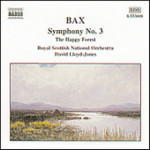
Bax: Symphony No. 3 / The Happy Forest
 $25.00
Out of Stock
$25.00
Out of Stock6+ weeks add to cart
ARNOLD BAX
Bax: Symphony No. 3 / The Happy Forest
Royal Scottish National Orchestra / David Lloyd-Jones
[ Naxos / CD ]
Release Date: Thursday 6 February 2003
This item is currently out of stock. It may take 6 or more weeks to obtain from when you place your order as this is a specialist product.
He dedicated the work, described by the viola-player Bernard Shore as 'as thrilling to playas to listen to,' to Sir Henry Wood, a champion of his music, who conducted the first performance of the symphony in March 1930.
"The Third, composed in 1928-29, is probably the most popular (and certainly the most often recorded) of the Bax symphonies. I suspect that's because it's the most immediately accessible. Both musically and emotionally it challenges its listeners far less forcefully than its rugged and crushing predecessors did; and it's arguably more focused than the baggy Fourth, and melodically more distinguished than the final three. Yet for all its superficial allure-for all the seductive thrall of its lyricism (especially in the sumptuous second movement and the reflective Epilog), for all the surge of its outburst (one can almost hear premonitions of the Korngold swashbucklers in the climax of the first movement)-it's far from sunny in spirit. The more robust passages (especially the militaristic outbursts in the finale) are often marked by an angry snarl; and while the introspective episodes rarely turn bleak (nothing here has the damp chill, the sense of overwhelming loss we hear in Tintagel), their typically Baxian ache swings the nostalgia toward the regretful rather than the merely sweet."
- Fanfare (Peter J. Rabinowitz), July-August, 2000
Lloyd-Jones "keeps his lines defined in the vital slow music of I and the Lento, clarifying textures while probing, molding, and shaping phrases to produce an ebb and flow. In doing so, he draws a link to Elgar by revealing the same nooks and crannies that make up Elgar's melodic lines just as wisely, Lloyd-Jones does not blur orchestral textures to create 'impressionism'. His woodwinds stand out, adding important color, energy, and briskness; the first violins are sweet and silvery, and the brass are crisp and clean. (The latter could be darker, but I'm quibbling.) Suddenly we notice the interweaving strings in the slow passage of I; the eerie spell before the muted trumpets (14:02) the shocking climax at 15:30 and the following brass fanfares, the way the trumpet solo in the Lento breathes rather than is just slow, etc."
- American Record Guide (Roger Hecht), July-August, 2000
Tracks:
Symphony No. 3
The Happy Forest